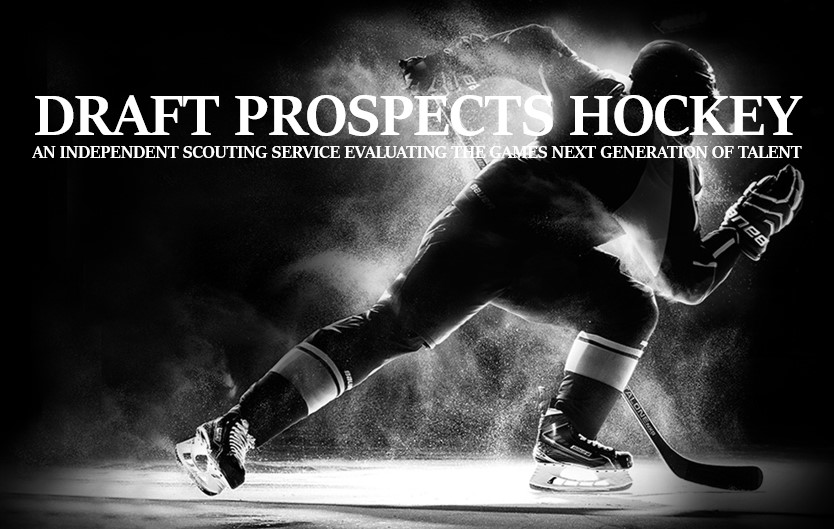THE ANALYTIC DARLINGS OF THE 2020 NHL DRAFT
By Dan Stewart

In my humble opinion, advanced stats or analytics, whatever you want to call them, are not and can never become a substitute for actually getting to the rink and watching how a player performs on the ice, being able to see a season or more worth of development and progression. The art of scouting, picking the right prospect for your team and one that will excel at the NHL level has too many variables to chalk it up to just a numbers crunch. But that is not to say that some of this data will not help. Quite the contrary, and NHL teams have openly accepted them as an add-on to actual scouting and evaluating.
The one statistic that stands out to me as a pretty good indicator of NHL success for draft prospects is the P1/E60 tracker which calculates the total primary points per estimated sixty minutes of ice time during their season. Primary points are important as it is proven that your primary point total indicates a play driving component to ones play more so than someone who builds point total through secondary assists, especially where forwards are concerned.
Also, by analyzing what prospects do on a somewhat even playing field, as in everyone getting the same time on ice, sixty minutes or one whole game, this eliminates the argument that one prospect might see more ice time than another when comparing. Being able to look at recent comparables and how they performed in the same league also aids to tighten down the projection. As the top end baseline comparable, back in his draft year NHL Superstar Connor McDavid had the highest recorded P1/E60 since the statistic started to be tracked in 2008, a ridiculous 6.08.
He had 94 primary points in his draft year while playing 47 total games for Erie of the OHL and accumulating 26 more secondary points for a total of 120 points. It blows your mind how good McDavid was during his draft year.
Than we have 2020 eligible forwards Quinton Byfield of Sudbury (4.48), Seth Jarvis of Portland (4.40), Emil Heineman of Leksands (4.19), Marco Rossi of Ottawa (4.18), Cole Perfetti of Saginaw (4.11), and 2020 NHL Draft headliner Alexis Lafreniere of Rimouski (4.01) nestled in between current NHL stars who in their DY (draft year) such as Taylor Hall who produced a P1/E60 at 5.01, Steven Stamkos at 4.94, Evander Kane at 4.84, Mitch Marner at 4.71, Leon Draisaitl at 4.71, Jonathan Drouin at 4.42, John Tavares at 4.39, Andrei Svechnikov at 4.26, Nathan Mackinnon at 4.01 and Tyler Seguin at 4.01.
Sure there are some who did not live up to the expected NHL upside comparable to their P1/E60 rating such as Portland forward Nic Petan who had a 4.36 in his draft year or Scott Glennie of Brandon who came in at 4.23 during his draft year, but those cases are few and far between.
On defense Ryan Ellis of the Nashville Predators holds the top P1/E60 since it was tracked in 2008 at 2.88, Tony DeAngelo of the New York Rangers is next at 2.41. Anything over a two is excellent for blueliners. Toronto’s Morgan Rielly had a DY P1/E60 of 1.88, top prospect Bowen Byram was 1.79 and Aaron Ekblad at 1.59, Tyson Barrie at 1.58, Seth Jones at 1.56, Drew Doughty at 1.52 and Alex Pietrangelo at 1.46 all give you an idea where the NHL stars sat in their draft years.
2020 eligible defender Samuel Johannesson of Rogle BK had a 2.41 P1/E60 against SHL competition leads the way as far as draft eligibles. However, he is in his DY+1 as he was passed over last season as was Lethbridge defender Alex Cotton who has a P1/E60 of 2.07. Of the true draft year defenders Anton Johannesson of HV71 leads the way at 2.05 with Tomi Niku of JYP second at 1.86 and Jacob Truscott of the US NTDP U18’s third at 1.67.
Of the highest ranked defenseman in the 2020 draft, Jamie Drysdale of Erie, our top ranked guy, had a 1.59 P1/E60. William Villeneuve of Saint John had a 1.56, Joni Jurmo of JYP had a 1.48, Emil Andrae of HV71 had a 1.47 and the drafts riverboat gambler, Mr. Offense, Jeremie Poirier of Saint John had a 1.46. Yes, this stat hides the powerplay specialist value from the point as the production is only calculated at even strength but is still gives you the even playing field data which is what we are after here.
Again, what analytics cannot tell us is if the prospect has a hitch in his skating stride that may keep him from producing at the next level when things move faster, or determine the work ethic and desire to succeed each prospect possesses, or if there is a reoccurring injury that might reduce his effectiveness as he progresses. It does not weight the pros and cons of physical abilities or size, if a prospect is too small to make the same impact against larger opponents, only showing what data has been produced on the ice. That is why combining the eyeball test with these analytics is so important.
So what does this all mean? Will Byfield be a more proficient scorer than Lafreniere at the NHL level? Honestly, the answer is not concrete, but adding some simple analytic data to the evaluation process allows us to both ask and partially answer that question – that is, who projects to be the best NHLer in this draft class?
And as it stands, where analytics are concerned, the comparable historical-based data suggest Byfield, Jarvis and the two Johannesson’s on defense could lead the pack for the 2020 NHL Draft.
Powered by www.pick224.com
